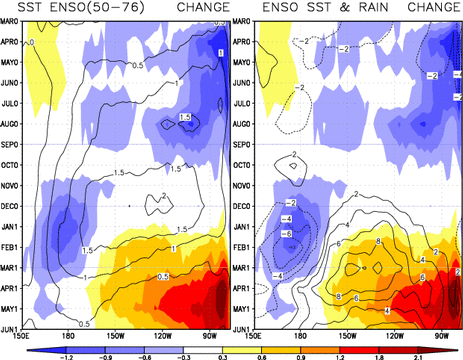5.1 Modeling studies of low frequency atmospheric variability and climate change
5.1.1 Atmospheric circulation change and the role of tropical SST warming
A significant component of global surface temperature trend since 1950 is linked with planetary scale changes in atmospheric wind and pressure patterns, and our analysis based on atmospheric GCM experiments indicates that the latter have been forced by changes in tropical SSTs. During northern winter, the trend in 500-mb heights since 1950 consists of a uniform tropical and subtropical height increase, and a wavy pattern of stationary wave change in higher latitudes highlighted by lower pressure over the North Pacific and North Atlantic (Fig. 5.2, top). The change in the latter region projects strongly on the North Atlantic Oscillation (NAO) structure of monthly variability. Recent hypotheses for the North Atlantic climate change include a positive feedback resulting from coupling with North Atlantic SSTs, and the possibility that the slow variations are nothing more than sampling artifacts of a random stationary process. Earlier studies of North Pacific climate change have also argued for forcing from the slow variations in extratropical (North Pacific) SSTs (see Fig. 5.1), together with forcing from changes in the tropical Pacific ocean. We have analyzed data from a 12-member ensemble of atmospheric simulations with NCAR's CCM3, using global SST variations since 1950, and these confirm that the observed circulation pattern trends are consistent with global air-sea interactions (Fig. 5.2, middle). The role of tropical SSTs is revealed from another GCM ensemble in which monthly SST variations are prescribed over only the 30N-30S band. That the observed trend is captured by the tropically forced simulations (Fig. 5.2, bottom) alone suggests that the gradual warming of those waters since 1950 is forcing NH climate change. In fact, further analysis suggests that the secular warming within the oceanic warm pool region itself is most relevant for the simulated climate change, particularly over the distant North Atlantic sector.
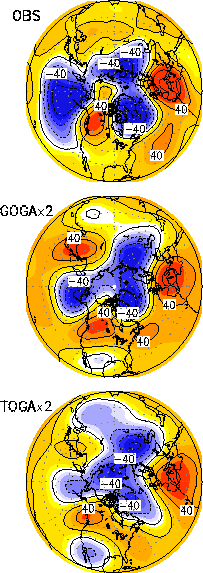
Tropical SST warming since 1950 has altered tropical rainfall, the likely immediate cause for the simulated atmospheric circulation changes. The modeled rainfall trend is consistent with that of the underlying SSTs, with increased precipitation throughout the entire equatorial Indo-Pacific region (Fig. 5.3, top). This leads to the question of the origin of the tropical SST change itself (Fig. 5.3, bottom). Analysis of coupled ocean-atmosphere experiments indicate that the warming trend is beyond the range of natural variability. The changes do appear consistent with anomalous greenhouse forcing, however, insofar as the pattern and amplitude of warming during the past half century is similar to that predicted by such models when forced by observed greenhouse gas changes. Our current working hypothesis is that the spatial pattern of NH winter climate change, and the regional change over the North Atlantic/European sector especially, is being forced by a tropical ocean warming, and implicitly reflects an emergent anthropogenic signal.
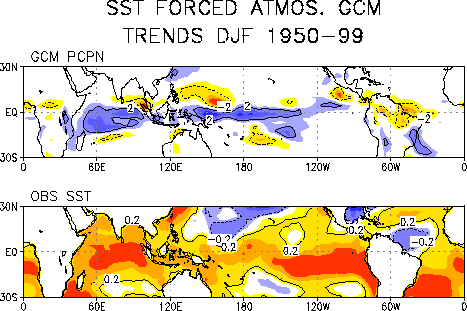
5.1.2 Global warming and atmospheric angular momentum
The recent trends in wintertime NH height are strongly annular from the surface to the lower stratosphere. Heights have been increasing in the tropics but decreasing near the poles, and associated with this has been an increase in the atmospheric angular momentum (AAM) (Fig. 5.4). Much of the increase reflects a change in relative angular momentum that is due to a broad westerly wind increase within 30N-30S. We have been seeking an explanation for this change using GCM simulations subjected to various forcings. First, the change of AAM was investigated in a three-member ensemble of coupled ocean-atmosphere model simulations with increasing atmospheric greenhouse gases and sulfate aerosol loading for the period 1900-2100. A highly significant increase in total AAM was found to occur in those runs, with an indication that the forced change emerges above the noise of natural variability by the late 20th Century.
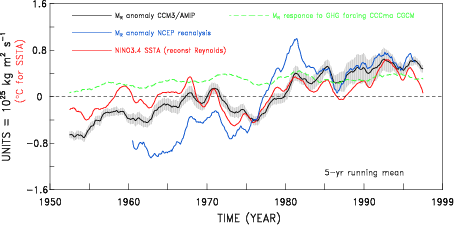
We hypothesize that the AAM is responding to SST changes and accompanying tropical convection, rather than to direct changes in radiative forcing. In the model, the AAM is found to accompany an increase in tropical SST with a sensitivity of ~1 AMU/C (1 AMU = 1025 kg m2 s-1). A similar sensitivity is found in the observed AAM response to Niño 3.4 SSTs during El Niño. To further examine the role of SST changes only, we analyzed a 12-member ensemble of NCAR CCM3 simulations forced with the history of global SSTs during 1950-99. The simulated AAM from these runs compares well with the time history of the (single realization) observed AAM, and with the observed trend in Niño 3.4 SSTs (see Fig. 5.4). The AAM time series in the greenhouse forced experiment also shows an increasing trend, though it appears to underestimate the observed low frequency variability. All four curves show a trend during 1950-99 of approximately the same magnitude, although the coupled run has the smallest and the observed AAM has the largest trend. The curves cluster together after 1980, while before that time the AMIP ensemble lies between the coupled ensemble and the observed curve. The implication is that the observed AAM trend is partially the result of global warming, through its effect on the tropical heat sources, although natural variability (and NCEP reanalysis errors) probably also contribute. In any case, the anthropogenic forced change through 1999 is as yet modest, especially compared to the AAM change predicted to occur by this model over the next 100 years (~ 4 AMU).
5.1.3 Decadal variations in ENSO and its global impact
Observations reveal that the global impacts of ENSO vary substantially on decadal time scales. One example is the breakdown in the ENSO-Indian monsoon relationship in the last quarter century. In addition to such changes in tropical teleconnections, ENSO's extratropical impacts have also shown strong decadal variations. For example, ENSO has explained a much higher fraction of the seasonal atmospheric variability in the PNA-sector since 1977 compared to the prior quarter century. The February-April seasonal correlation of 500-mb heights with a SST index of ENSO has roughly doubled during 1977-99 compared to 1948-76 (Fig. 5.5). The correlation, averaged across the southern US between 120W-70W, increases from roughly -0.2 to -0.6 in the recent period, and points to a substantial increase in the late-winter potential predictability.
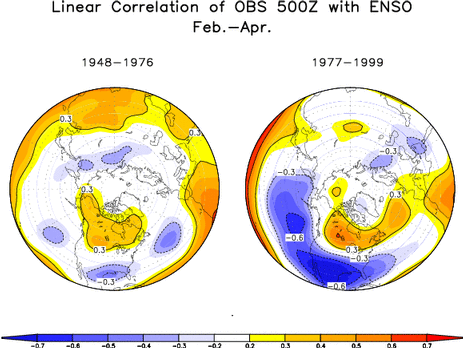
One might suppose that this change in predictability is due to the stronger ENSO forcing as measured by the increased interannual variance of tropical Pacific SSTs since 1977 (see Fig. 5.1). Yet, this increase is only about 20 percent, and it is not reconcilable with the much greater fractional increase in variance of the remote ENSO signal. Recent changes in the life cycle of tropical Pacific SST anomalies during warm events may be a key factor. The so-called canonical warm event evolution prior to 1977, using the cases of Rasmusson and Carpenter, had peak warming in December, followed by rapid decay (Fig. 5.6, left panel contours). We have calculated the difference in SST lifecycles between the post-1977 and pre-1977 warm events (Fig. 5.6, left panel shading), and found that recent cases prolong their warming into spring of year+1, and also defer South American coastal warming until spring of year (+1). This change is relevant for the teleconnections because the recent warm events peak closer to the peak in climatological warming of the east equatorial Pacific ocean, so that the total SST is actually now maximized in spring of year+1 rather than in early winter. Using output from AMIP-style simulations spanning 1950-99, we have found a large increase in rainfall for the post-1977 events relative to the pre-1977 events (Fig. 5.6, right panel contours) that corresponds closely with the change in SSTs. The change in composite rainfall represents a doubling relative to the pre-1977 cases, suggesting that the recent teleconnection strength is at least qualitatively consistent with a secular change in tropical forcing, though other factors may also be involved.
